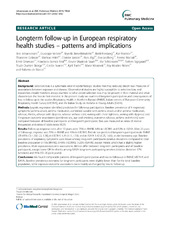| dc.description.abstract | Background: Selection bias is a systematic error in epidemiologic studies that may seriously distort true measures of associations between exposure and disease. Observational studies are highly susceptible to selection bias, and researchers should therefore always examine to what extent selection bias may be present in their material and what characterizes the bias in their material. In the present study we examined long-term participation and consequences of loss to follow-up in the studies Respiratory Health in Northern Europe (RHINE), Italian centers of European Community Respiratory Health Survey (I-ECRHS), and the Italian Study on Asthma in Young Adults (ISAYA). Methods: Logistic regression identified predictors for follow-up participation. Baseline prevalence of 9 respiratory symptoms (asthma attack, asthma medication, combined variable with asthma attack and/or asthma medication, wheeze, rhinitis, wheeze with dyspnea, wheeze without cold, waking with chest tightness, waking with dyspnea) and 9 exposure-outcome associations (predictors sex, age and smoking; outcomes wheeze, asthma and rhinitis) were compared between all baseline participants and long-term participants. Bias was measured as ratios of relative frequencies and ratios of odds ratios (ROR). Results: Follow-up response rates after 10 years were 75% in RHINE, 64% in I-ECRHS and 53% in ISAYA. After 20 years of follow-up, response was 53% in RHINE and 49% in I-ECRHS. Female sex predicted long-term participation (in RHINE OR (95% CI) 1.30(1.22, 1.38); in I-ECRHS 1.29 (1.11, 1.50); and in ISAYA 1.42 (1.25, 1.61)), as did increasing age. Baseline prevalence of respiratory symptoms were lower among long-term participants (relative deviations compared to total baseline population 0-15% (RHINE), 0-48% (I-ECRHS), 3-20% (ISAYA)), except rhinitis which had a slightly higher prevalence. Most exposure-outcome associations did not differ between long-term participants and all baseline participants, except lower OR for rhinitis among ISAYA long-term participating smokers (relative deviation 17% (smokers) and 44% (10–20 pack years)). Conclusions: We found comparable patterns of long-term participation and loss to follow-up in RHINE, I-ECRHS and ISAYA. Baseline prevalence estimates for long-term participants were slightly lower than for the total baseline population, while exposure-outcome associations were mainly unchanged by loss to follow-up. | en_US |

